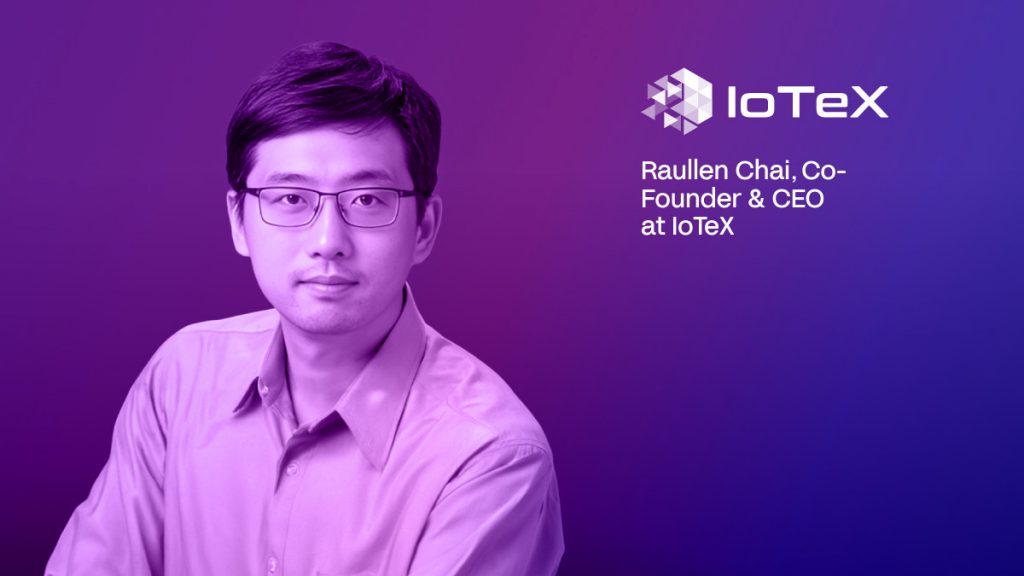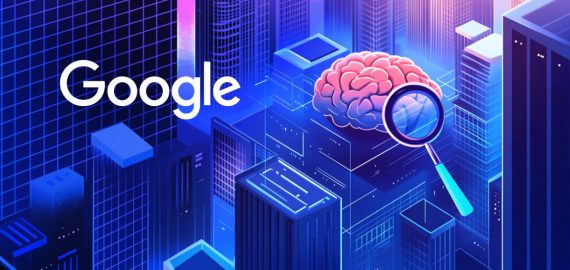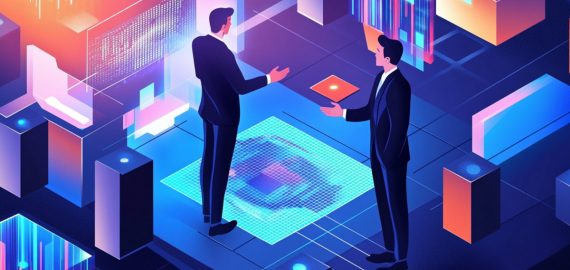Blockchain Meets the Real World: How IoTeX is Bridging the Gap Between Crypto and Everyday Technology


In Brief
Raullen Chai, CEO of IoTeX, discusses the company’s innovative solutions and roadmap for integrating blockchain technology with real-world applications, addressing privacy, scalability, and user adoption challenges.

In this interview, Raullen Chai, Co-Founder and CEO of IoTeX, unveils how IoTeX is spearheading the integration of blockchain technology with real-world applications, addressing challenges in privacy, scalability, and user adoption. From the company’s innovative solutions to its ambitious roadmap, this conversation offers a glimpse into the future of decentralized technology and its potential to enhance our interaction with smart devices and digital infrastructure.
Can you share your journey to Web3? How did you start, and what was your first project?
My journey began with a focus on IoT, which evolved into blockchain. The IoT-blockchain narrative started around 2016-2017. Initially, people explored using blockchain for micro-payments in IoT devices, but this approach didn’t work well.
The second attempt focused on privacy, using blockchain to ensure data from consumer IoT devices like smart home cameras, phones, and cars was privacy-preserving. This worked to some extent, but consumers didn’t care much about privacy.
The third attempt, which is where we are now with DePIN, uses tokens to grow networks of devices that serve people and generate revenue. It’s similar to the sharing economy model of Uber or Airbnb but tokenized.
How does your company’s approach to privacy in IoT and DePIN applications differ from other blockchain projects?
We explored privacy-focused approaches around 2021 with a smart home camera that had blockchain-based privacy-preserving technology. We sold about 20-25k of these cameras in the United States, which wasn’t bad.
However, we learned that people don’t really care much about privacy. For crypto and blockchain to achieve mass adoption, we need to offer something people care about. That’s why DePIN makes sense – it provides passive income for everyday people, which is something they love.
How would you explain DePIN to people who need to become more familiar with blockchain?
DePIN has two sides. On the demand side, it’s about providing services like wireless coverage, 5G, transportation, or energy to people, regardless of whether they’re in developed areas with modern infrastructure or in developing regions.
On the supply side, we’re working to make it easier for builders to create DePIN projects. Building a DePIN network is challenging because it involves hardware, communication between hardware and blockchain, smart contracts, and web and mobile applications.
We want to reduce the burden for DePIN builders, making it as easy as building a DeFi application. By lowering the entry barrier, we hope to see many DePIN networks emerge, with some evolving to truly serve everyday people.
How does IoTeX’s DePIN liquidity hub aim to solve liquidity issues for DePIN tokens?
The DePIN liquidity hub is one of our public goods. It addresses the challenge new DePIN projects face when their tokens aren’t yet listed on good exchanges and lack liquidity. The hub provides initial liquidity for these new tokens, which are supported by IoTeX. This allows projects to grow their device networks from 0 to 100 or 1,000 devices, helping them jumpstart their vision.
Did you face any problems or issues while implementing DePIN solutions and increasing adoption among developers?
The main challenge is the complicated tech stack of DePIN projects. It requires team members to work on firmware, hardware, software, blockchain, smart contracts, and mobile applications. This creates a high barrier for many builders.
That’s why, in IoTeX 2.0, we’re focusing on modularity. We’re abstracting each component into modules that developers can easily adopt and use without knowing all the details. It’s like building with Lego blocks – DePIN builders can easily launch projects by combining different modules.
How do you see the current state of modularity in blockchain?
Modularity is a well-established thesis in the software industry, especially in infrastructure software. It’s being applied to blockchain, with Celestia being a notable example in the layer 1 and layer 2 space.
As blockchains become more complex, modularity becomes almost inevitable. Ethereum, for example, now has layers 1 and 2, as well as data availability layers, and is discussing proposer-builder separation. Modularity helps break down these complex systems into manageable pieces that different teams can work on. We’re aiming to apply this same success to DePIN, which has an even more complicated tech stack.
What role does IoTeX envision for itself in the decentralized AI sector, particularly in addressing the challenges associated with decentralized computation for large AI models?
AI can greatly benefit from DePIN. The three key factors for a successful AI company are compute power, good models, and lots of domain-specific data. DePIN can help with all three. Projects like Iodanet and Akash are implementing decentralized GPU sourcing for AI algorithms.
BitTensor is working on ways for different models to compete in problem-solving. We have several projects on IoTeX working on data sourcing and aggregation for AI models, such as Network 3, Environment Blocks, and PowerPoint. We’ve been an infrastructure provider for these AI-themed projects, and the results have been promising.
Does IoTeX use AI internally for any services, such as data analysis?
Yes, we use AI internally to increase team productivity. We use ChatGPT for things like meeting notes, policy write-ups, and logistics arrangements.
How does IoTeX technology address the challenge of trusting IoT data when it comes to using this data for smart contract execution or AI training?
This is a big part of our 2.0 vision, which we call DePIN Verification. As DePIN grows, we’ll have millions of devices sending data back to the blockchain to prove they’ve done a job. To handle this volume of data, we need off-chain computing infrastructure. We’re co-building with projects like Filecoin and RISC Zero to store data and produce ZK-SNARKs to prove, for example, that a car moved from point A to B. These concise proofs can be verified by smart contracts, allowing us to efficiently process and verify large amounts of IoT data.
How do you foresee the future integration of DePIN technologies with emerging trends such as 5G networks and edge computing?
We have two projects working on these areas. For edge computing, Network 3 is deploying devices close to where people are, collecting and computing data on-site to minimize latency. For 5G, we have a project called Wayru that aims to replicate Helium’s success in Latin America. While DePIN networks won’t fully replace traditional telecom networks, they can be a valuable enhancement in regions where traditional infrastructure is lacking.
What developments do you anticipate in the DePIN sector over the next three years?
We’ve seen many more DePIN projects emerging since Q4 of last year, especially from people with domain experience in transportation, energy, and consumer IoT. This trend is ongoing. DePIN has the potential to bring crypto to everyday people in a user-friendly way.
Just as people use iPhones without understanding the complexity inside, DePIN can offer simple devices that provide value or income to users, making them crypto users without them even realizing it. With major capital entering the crypto space, as evidenced by the recent approval of Ethereum ETFs, crypto is eating the world, and DePIN is at the forefront.
Can you provide an update on the IoTeX roadmap? Are there any upcoming solutions or new partnerships in the pipeline?
For IoTeX 2.0, we’re working with many infrastructure projects to bring them into the DePIN space, including projects focused on ZKPs, storage, data streaming, messaging, and identities.
We’re also working with DePIN builders to lower the entry barrier, offering an accelerator program with advice and seed-round investments. In the next three years, we see potential for aggressive growth in terms of the number of DePIN projects we can power, potentially 100 times more than we have now.
Disclaimer
In line with the Trust Project guidelines, please note that the information provided on this page is not intended to be and should not be interpreted as legal, tax, investment, financial, or any other form of advice. It is important to only invest what you can afford to lose and to seek independent financial advice if you have any doubts. For further information, we suggest referring to the terms and conditions as well as the help and support pages provided by the issuer or advertiser. MetaversePost is committed to accurate, unbiased reporting, but market conditions are subject to change without notice.
About The Author
Victoria is a writer on a variety of technology topics including Web3.0, AI and cryptocurrencies. Her extensive experience allows her to write insightful articles for the wider audience.
More articles

Victoria is a writer on a variety of technology topics including Web3.0, AI and cryptocurrencies. Her extensive experience allows her to write insightful articles for the wider audience.

















































